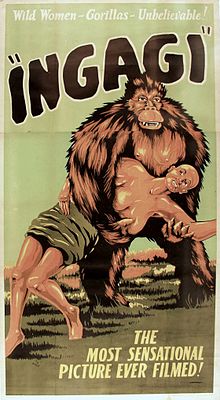Ingagi
| Ingagi | |
|---|---|

Theatrical poster to Ingagi
|
|
| Directed by | William Campbell |
| Produced by | William D. Alexander Nat Spitzer (executive) |
| Written by | Adam Shirk |
| Starring | Charlie Gemora as Ingagi |
| Music by | Edward Gage |
| Cinematography | L. Gillingham |
| Distributed by | Congo Pictures |
|
Release date
|
|
|
Running time
|
75 min |
| Country | United States |
| Language | English |
Ingagi is a lost 1930 Pre-Code exploitation film. It purports to be a documentary about "Sir Hubert Winstead" of London on an expedition to Africa, and depicts a tribe of gorilla-worshiping women encountered by the explorer. The film claims to show a ritual in which African women are given over to gorillas as sex slaves, but in actuality was mostly filmed in Los Angeles, using white actresses in blackface in place of natives. It was produced and distributed by Nat Spitzer's Congo Pictures, which had been formed expressly to make the film. Although marketed under the pretense of being an ethnographic film, the premise was a fabrication, leading the Motion Picture Producers and Distributors Association to retract any involvement with the film.
The film trades heavily on its nudity and on the suggestion of sex between a woman and a gorilla. Its success motivated RKO Radio Pictures to invest in the 1933 film, King Kong. RKO owned several of the theatres Ingagi where was shown, including one of the first, the Orpheum Theatre in San Francisco, where it opened April 5, 1930.
The later Son of Ingagi (1940) is not a sequel but is the first all-black cast horror movie and features a house haunted by a female mad scientist and her missing link monster.
...
Wikipedia
